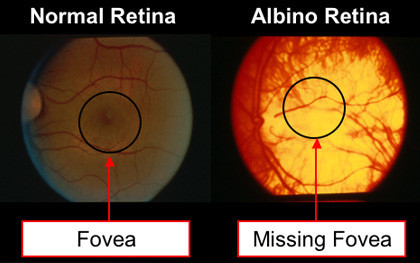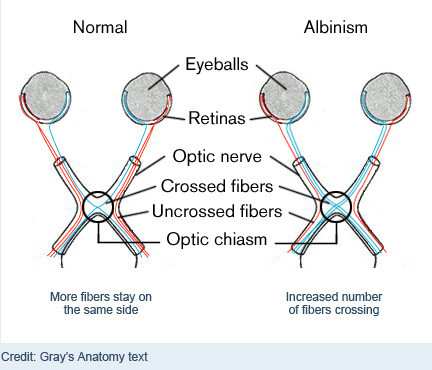
Albinism Genetics
Albinism is an inherited genetic condition. Most forms of albinism are recessive, which means a child inherits one abnormal gene from each parent.
Most children with albinism are born to parents with normal pigmentation. These parents — like one in every 75 people — are carriers for albinism. A carrier is someone who has one abnormal gene and one that functions normally. Because the functional gene overrides the abnormal one, these people do not have albinism themselves. However, they are still able to pass the abnormal gene on to their child. This type of inheritance is called “autosomal recessive”.
When two people are carriers of the albinism gene, they have a one in four chance that the child will have albinism, one in two chance that the child will not have albinism but be a carrier and a one in four chance that the child will neither be a carrier nor have albinism.
Simply put, DNA is a molecule that carries genetic information or instructions telling our bodies how to function and develop. The DNA in the albinism gene (different for each type of albinism explained below) does not contain the instructions for the body to create as much pigment needed for various functions – including vision.
Types of Albinism
To date, there are several identified types of albinism. Below you will find a brief description of each:
Ocular Albinism (OA) affects only the eyes, not the skin or hair. It results from an X-linked chromosomal inheritance and so occurs mostly in boys.
Oculocutaneous Albinism (OCA) affects the eyes, hair and skin and includes several different forms. The first form, OCA1 involves the tyrosinase enzyme, which converts tyrosine (an amino acid) into melanin. Melanin is a chemical that colors our skin, eyes and hair. OCA1 includes two sub-groups:
- OCA1a: Those with this type of albinism have no pigment and no active tyrosinase
- OCA1b: Those with this type of albinism have some residual tyrosinase activity and so have some pigment. Although they have decreased pigmentation at birth, it may increase slightly throughout their lives. People in this group may even have the ability to sun tan.
Another form of OCA, OCA2, affects the p-protein, another protein involved in melanin production. It is much more common in persons of African descent. People in this group have some pigment, but typically do not tan. Yet another form of OCA, OCA4, is clinically indistinguishable from OCA2. However, it involves the SLC45A2 gene, which produces another protein involved in melanin production.
Hermansky-Pudlak Syndrome (HPS) is a rare type of albinism, which has an increased incidence among people of Puerto Rican descent. It may involve bleeding disorders, bruising, lung problems, and intestinal disorders. For more information, please go to HPSNetwork.org or the HPS Network Facebook page.
Chediak-Higashi Syndrome is another rare form of albinism. It is characterized by an abnormality in certain types of white blood cells, lowering resistance to infection. Click here for more information.
Griscelli Syndrome is an extremely rare type of albinism. In fact, there are only 60 known cases worldwide. Like Chediak-Higashi Syndrome, it involves immunodeficiency and may also have associated neurological problems. You can learn more here.
Albinism’s Impact on Vision
Another form of OCA, OCA2, affects the p-protein, another protein involved in melanin production. It is much more common in persons of African descent. People in this group have some pigment, but typically do not tan. Yet another form of OCA, OCA4, is clinically indistinguishable from OCA2. However, it involves the SLC45A2 gene, which produces another protein involved in melanin production.
Hermansky-Pudlak Syndrome (HPS) is a rare type of albinism, which has an increased incidence among people of Puerto Rican descent. It may involve bleeding disorders, bruising, lung problems and intestinal disorders. For more information, please go to HPSNetwork.org or the HPS Network Facebook page.
Chediak-Higashi Syndrome is another rare form of albinism. It is characterized by an abnormality in certain types of white blood cells, lowering resistance to infection. Click here for more information.
Griscelli Syndrome is an extremely rare type of albinism. In fact, there are only 60 known cases worldwide. Like Chediak-Higashi Syndrome, it involves immunodeficiency and may also have associated neurological problems. You can learn more here.
The following parts of the eye are affected in an individual with albinism:
The Retina

- The retinal pigment epithelium contains the cells that convert visual input into signals to send to the brain. A lack of pigment in these cells leads to a decreased ability to process visual input. It also leads to a decreased ability to absorb stray light, leading to light sensitivity and the red reflex that is sometimes noticeable as a violet hued iris in people with albinism.
- The fovea is the center of the macula – the area of the retina responsible for our central, sharpest vision. In a normal eye, the macula is the area of a person’s best vision that focuses on an image such as a person’s face. The fovea zeros in on detail such as seeing a freckle on someone’s face. In people with albinism, the fovea is underdeveloped and lacking in pigment. This is known as foveal hypoplasia. Foveal hypoplasia is perhaps the greatest cause of vision problems in an individual with albinism.
The Optic Nerve

- The optic nerve is the connection from the eye to the brain. Between the eye and the brain, there is an area known as the optic chiasm. This area is where the optic nerve splits into separate fibers which are routed to the brain.
- In normal-sighted people, most of the fibers stay on the same side of the brain while some cross to the opposite side. This helps with “binocular vision” (using both eyes) and, in turn, depth perception.
- In people with albinism, too many fibers cross to the opposite side, giving the brain an abnormal signal. This leads to the difficulty with depth perception that often occurs in albinism.
The Iris
- The iris is the colored part of the eye. It helps control the amount of light entering the eye.
- An insufficient amount of pigment in the iris of individuals with albinism results in a decreased ability to filter light entering the eye. The decreased pigment also leads to trans-illumination defects of the iris, which is light reflecting back through the poorly pigmented iris. The detection of trans-illumination defects during an eye exam by an ophthalmologist is an indication of albinism.
- People with albinism are often sensitive to bright lights and glare, which is usually helped by wearing sunglasses.
Common Vision Problems
The differences in the structure of the eye of individual with albinism all lead to a wide range of visual acuity. One the first things a parent often wonders is ‘what will my child see? What will his acuity be?’ People with albinism are generally considered to have ‘low vision’ or be ‘visually impaired’ which means that their vision reduction cannot be corrected with standard glasses or contact lenses. It is not possible to predict what a child’s vision will be in infancy because it depends on many factors. However, the most common vision problems associated with albinism are:
1. Reduced visual acuity. Primarily due to the differences in the retina described above, individuals with albinism have a reduced visual acuity. Visual acuity refers to the ability to see fine detail. An individual’s visual acuity is an indication of the clarity or clearness of what they are seeing. Visual acuity is typically measured by reading letters on an eye chart. The measurement given is based on what a normal human being should be able to see when standing 20 feet away from the eye chart. If an individual has 20/20 vision, it means that when he stands 20 feet away from the chart, he can see what a normally-sighted individual can see at 20 feet away. (In the metric system, the standard is 6 meters and it’s called 6/6 vision.) In other words, if an individual has 20/20 vision, his vision is ‘normal’ – a majority of people in the population can see what he can see at 20 feet. If an individual has 20/100 vision, it means that when he stands 20 feet away from the chart he can only see what a normally-sighted person can see when standing 100 feet from the chart. The best-corrected visual acuity for most people with albinism can vary between 20/30 and 20/400. In general, an individual with albinism, even after their vision is corrected with glasses or lenses, must be much closer to the chart to see the same lines than a normally-sighted person. Best-corrected visual acuity is the measure of best acuity while wearing corrective lenses like glasses or contact lenses.
2. Light Sensitivity. The lack of pigment in the retina and iris generally makes people with albinism sensitive to bright light and glare. You may notice your child squint or cover their eyes in environments with bright light. Tinted glasses and sunglasses outside can help your child most effectively use their vision.
3. Nystagmus. This disorder is characterized by an irregular, side-to-side involuntary eye movement that may be side-to-side, up and down or rotary. Although people with nystagmus do not sense their eyes are moving, this disorder does make it more difficult to focus on visual details. Nystagmus does not go away or disappear but it usually becomes less noticeable with age. Conversely, the eye movements usually become more noticeable if a child is tired, nervous, or stressed. There is a procedure, known as a tenotomy, that, although in early stages, has shown some promise in improving nystagmus. For more information on nystagmus, there is a book called ‘Navigating Nystagmus with Your Doctor’ by Edie Glaser. In addition, there is wonderful online support group, American Nystagmus Network, that is very helpful. For more information on the tenotomy procedure, you can also contact Dr. Robert Burnstine of Akron Childrens Hospital, at [email protected].
4. Strabismus is a muscle imbalance of the eye which leads to crossing of the eyes or a “lazy eye.” In esotropia, the eye turns inward. In exotropia, the eye turns outward. If uncorrected, this can lead to amblyopia, or the loss of some vision function in the weaker eye. Strabismus is correctable with glasses, eye-patches and/or surgery.
5. Delayed Visual Maturation. A small percentage of children with albinism show no signs of usable vision for the first few months of their lives. They do not seem to track objects or make eye contact. It may seem like they don’t see anything. While this can be very frightening for a parent, it is temporary and is not thought to indicate less vision overall. At about six months of age, some parents report their child acted as though a ‘switch’ was turned on and it seems that from this point, their vision developed at the same rate as that of other children with albinism.
A note to the reader: The purpose of this content is to describe the ophthalmic complications related to albinism, how these complications affect vision, how they are diagnosed and the associated treatments currently available. Whenever possible, this content is written in laymen’s terms. This content is not meant for medical professionals or for a person with albinism who is trying to decipher which treatment is best for them. Rather, this content is meant to provide the reader (most likely a parent or individual with albinism) with a better understanding of albinism. Albinism affects individuals very differently and the reader should always rely on his or her medical doctor when diagnosing and treating any condition.